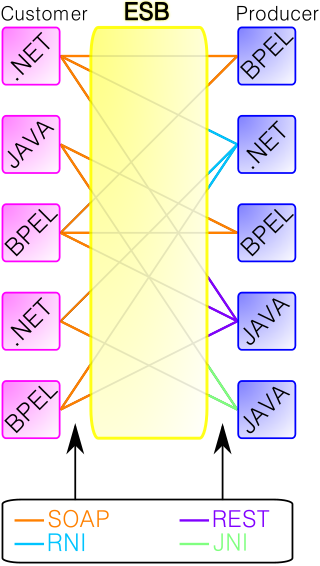
Martin Fowler is a British software developer, author and international public speaker on software development, specialising in object-oriented analysis and design, UML, patterns, and agile software development methodologies, including extreme programming.

OSGi is an open specification and open source project under the Eclipse Foundation.
The Jakarta Messaging API is a Java application programming interface (API) for message-oriented middleware. It provides generic messaging models, able to handle the producer–consumer problem, that can be used to facilitate the sending and receiving of messages between software systems. Jakarta Messaging is a part of Jakarta EE and was originally defined by a specification developed at Sun Microsystems before being guided by the Java Community Process.

Jakarta EE, formerly Java Platform, Enterprise Edition and Java 2 Platform, Enterprise Edition (J2EE), is a set of specifications, extending Java SE with specifications for enterprise features such as distributed computing and web services. Jakarta EE applications are run on reference runtimes, which can be microservices or application servers, which handle transactions, security, scalability, concurrency and management of the components they are deploying.
Software design pattern refers to a reusable, proven solution to a specific, recurring problem typically focused on component-level design, though they can sometimes span multiple components. Design patterns address specific issues related to object creation, interaction, or behavior.
In software, a data access object (DAO) is a pattern that provides an abstract interface to some type of database or other persistence mechanism. By mapping application calls to the persistence layer, the DAO provides data operations without exposing database details. This isolation supports the single responsibility principle. It separates the data access the application needs, in terms of domain-specific objects and data types, from how these needs can be satisfied with a specific DBMS.

An enterprise service bus (ESB) implements a communication system between mutually interacting software applications in a service-oriented architecture (SOA). It represents a software architecture for distributed computing, and is a special variant of the more general client-server model, wherein any application may behave as server or client. ESB promotes agility and flexibility with regard to high-level protocol communication between applications. Its primary use is in enterprise application integration (EAI) of heterogeneous and complex service landscapes.
EGL, originally developed by IBM and now available as the EDT open source project under the Eclipse Public License (EPL), is a programming technology designed to meet the challenges of modern, multi-platform application development by providing a common language and programming model across languages, frameworks, and runtime platforms.
An enterprise messaging system (EMS) or messaging system in brief is a set of published enterprise-wide standards that allows organizations to send semantically precise messages between computer systems. EMS systems promote loosely coupled architectures that allow changes in the formats of messages to have minimum impact on message subscribers. EMS systems are facilitated by the use of structured messages, and appropriate protocols, such as DDS, MSMQ, AMQP or SOAP with web services.

Apache Geronimo is an open source application server developed by the Apache Software Foundation and distributed under the Apache license.
WebSphere Application Server (WAS) is a software product that performs the role of a web application server. More specifically, it is a software framework and middleware that hosts Java-based web applications. It is the flagship product within IBM's WebSphere software suite. It was initially created by Donald F. Ferguson, who later became CTO of Software for Dell. The first version was launched in 1998. This project was an offshoot from IBM HTTP Server team starting with the Domino Go web server.
The Bean Scripting Framework is a method of allowing the use of scripting in Java code. It provides a set of Java classes which provides support within Java applications for scripting languages, and also allows access to Java objects and methods. Some examples of languages that can be used in combination with BSF and Java include Python, Jython, ooRexx and Tcl, as well as JRuby and Apache Groovy using their own libraries.
Service Data Objects is a technology that allows heterogeneous data to be accessed in a uniform way. The SDO specification was originally developed in 2004 as a joint collaboration between Oracle (BEA) and IBM and approved by the Java Community Process in JSR 235. Version 2.0 of the specification was introduced in November 2005 as a key part of the Service Component Architecture.
Grails is an open source web application framework that uses the Apache Groovy programming language. It is intended to be a high-productivity framework by following the "coding by convention" paradigm, providing a stand-alone development environment and hiding much of the configuration detail from the developer.
IBM App Connect Enterprise (abbreviated as IBM ACE, formerly known as IBM Integration Bus, WebSphere Message Broker, WebSphere Business Integration Message Broker, WebSphere MQSeries Integrator and started life as MQSeries Systems Integrator. App Connect IBM's integration software offering, allowing business information to flow between disparate applications across multiple hardware and software platforms. Rules can be applied to the data flowing through user-authored integrations to route and transform the information. The product can be used as an Enterprise Service Bus supplying a communication channel between applications and services in a service-oriented architecture. App Connect from V11 supports container native deployments with highly optimised container start-up times.
Jakarta Persistence, also known as JPA is a Jakarta EE application programming interface specification that describes the management of relational data in enterprise Java applications.
OpenJPA is an open source implementation of the Java Persistence API specification. It is an object-relational mapping (ORM) solution for the Java language, which simplifies storing objects in databases. It is open-source software distributed under the Apache License 2.0.
HCL Commerce Cloud is a proven e-commerce solution designed to support extremely high transaction and site traffic volumes on a single deployed instance and supports all business models including B2C, B2B, B2B2C, D2C and MarketPlaces. HCL Commerce Cloud is built on the Java - Java EE platform using open standards, such as XML, and Web services. Formerly a product of IBM, the product was sold to HCL Technologies in July 2019.
HCL Digital Experience is an enterprise software used to build and manage web portals. It provides access to web content and applications, while delivering personalized experiences for users.
Gennaro "Jerry" Cuomo is an American software engineer who has worked for IBM since 1987. Holding the title of IBM Fellow, Cuomo is known as one of the founding fathers of IBM WebSphere Software, a software framework and middleware that hosts Java-based web applications.




